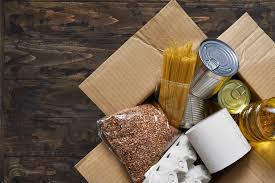Last Updated on June 6, 2023 by admin_hunter
Many survival foods come packaged in plastic bins that can be stored in a cool, dry area away from rodents, sunlight, and moisture. Look for items that are freeze-dried and vacuum-sealed to extend their shelf life.
These emergency ration bars from Datrex pack a lot of calories into small packages and taste like granola or cliff bars. Each bar supplies 200 calories.
Sweet Potatoes
Sweet potatoes should be a staple of any survival food stockpile because they’re nutritious, taste good, and store well. They provide a healthy source of carbs and can be eaten roasted, boiled, steamed, or baked. They’re packed with Vitamin C and beta carotene, too. Sweet potatoes also have a high calorie count, so they can give you a lot of energy in a short amount of time.
Another important item to add to your survival food stash is white rice. It lasts much longer than brown rice, and it’s a great substitute for pasta or beans in any dish. If you want to increase its shelf life even further, vacuum seal it.
You should also stock up on canned meats like spam, smoked ham, Vienna sausages, potted meat, or roast beef hash. These foods are rich in protein and provide the calories you need to stay alive in an emergency situation. Be sure to buy small cans so they take up less space in your storage area.
Other essential survival foods include sugar and salt. These can be used to flavor bland survival foods and help make them palatable in a crisis. They can also keep other foods from spoiling too quickly.
Other key survival foods are nuts and seeds, which are full of protein and fats. They’re commonly sold in the bulk food section of grocery stores and typically come unsalted. They’re also light-weight and a convenient snack to have on hand in a survival scenario.
Herbs
Herbs can provide medicinal properties, flavor to bland survival foods, and nutrition. They also help keep other food fresh and safe. Purchase them dried, or grow your own, and store them in airtight containers. Some examples include parsley, sage, rosemary, oregano, basil, and thyme. They can last several years when stored properly, and you can rotate them to make sure they are still fresh.
Other herbs can add a pleasant taste to bland survival meals and can be used as seasoning. Some dried herbs may have a shorter shelf life, so purchase small amounts at one time and discard any that are expired.
Some other herbs that should be in your survival food supply are mint, lavender, and oregano. They have antiseptic qualities and can be used to season soups, meat dishes, and drinks. They are easy to grow and can be harvested quickly, making them a great option for emergency survival food stockpiles.
A variety of herbs are also good to have on hand in case you need to use them for medical purposes in a crisis. Some are useful as antidotes, and others can be used to treat infections, ease fevers, and prevent vomiting.
Having some dried herbs on hand is also helpful, as they are more affordable than many other survival foods and can be stored for a long period of time. Dried mint, oregano, and rosemary are some of the most popular choices for survival food.
Other nonperishables that should be included in your emergency survival food supply are salt and sugar. Salt helps enhance the flavor of bland survival foods and can be used as a preservative. Sugar can be used as a sweetener and can last up to two years when stored properly. Honey is another natural sweetener that should be included in your survival food supplies. If it crystallizes, it can be reconstituted by warming it.
Canned Meats
Canned meat is a survival food staple because it can be stored for long periods of time and provides you with protein when fresh food may be scarce. Canned tuna, Vienna sausages and Spam are all good choices to have on hand. Look for brands without too much salt and that are high in calories to provide energy when you need it most.
You should also stock up on dried fruits. They are an excellent source of nutrients and will last much longer than fresh fruit when stored in a cool, dry place. Dried fruits are also high in potassium, a mineral that can help prevent muscle cramps during prolonged exercise.
If you’re going to shop for canned meats and fruits, consider picking up a few cans of spices as well. These aren’t just for taste, but they can help to boost your immune system and keep you healthy during a disaster. If you buy them in bulk, they are relatively inexpensive.
Other foods that are important to have on hand during a disaster include energy bars, nuts and chocolate bars. These are ideal if you anticipate that you will need to expend a lot of energy escaping a disaster or walking for miles on foot. Look for ones that are high in calories and have a wide range of vitamins and minerals.
You should also stock up on brown rice, rolled oats and other whole grains. These are better for you than white rice, which is processed, and contain more of the hull and germ. Other good options are wheat, flaxseed and barley. Also, consider storing a container of distilled water. It has a longer shelf life than regular tap water and will not grow algae or other microorganisms.
Canned Vegetables
Fresh foods that last several years like vegetables and fruits should be part of your survival food stockpile. Purchasing canned vegetables without the liquid and sealing them in airtight containers with moisture absorbers is a good way to save money while getting all the nutrients you need for your survival food storage. Consider storing mixed canned soups and beans as well to give you a variety of meals.
If you are planning on a prolonged crisis, it is a smart idea to store some canned meats. They will help you get the proteins you need to stay healthy and active. Canned tuna, Vienna sausages and potted meat are some of the best options for your survival food supplies.
You should also stockpile some canned foods that have a long shelf life such as instant potato flakes. These are easy to make and can be rehydrated with water. They are also packed with a lot of calories and provide a good source of carbs for energy.
Other items to add to your survival food storage include dried pasta, brown rice and rolled oats. While a bit more expensive than regular supermarket products, they last up to 15 years when sealed in an airtight container with moisture absorbers. They are great options for your emergency pantry, as they do not spoil and can be stored in a cool, dark place.
A few cans of sliced meat, fish or poultry can also be added to your survival food supplies. They are not as convenient as canned vegetables but they will provide you with a substantial amount of protein and the nutrients you need to survive. You should also have some dairy products on hand for your survival food supply, including milk and cheese. This will provide you with calcium for your bones and teeth. You can also purchase ready-to-eat canned eggs for a high-protein option that is not dependent on refrigeration.
Dried Fruits
Having dried fruits in your survival stash can help keep you from becoming scurvy in a long-term disaster situation. Aside from providing a nutrient boost, this type of food is loaded with sugars that can provide you with energy. Some of the most common dried fruits include apricots, prunes, dates and figs. They are also high in bioactive compounds and nutrients such as potassium, iron, folate, calcium and magnesium.
Fruit can be processed in several ways to preserve it, including dehydrating with or without preservation chemicals and freeze drying. These methods retain the flavor and nutrient value of the food and can last a year or more when stored properly. If possible, dry-pack your own fruits with moisture absorbers in order to make them last longer.
Dried fruits are ideal for emergency meals because they do not require cooking and don’t take up much space in a survival backpack or food storage bag. They can easily be added to cereals, salads, entrees and other dishes for an extra kick of sweetness and flavor.
You can also find dried fruits at most grocery stores in the bulk seed/nut area. Be sure to look for unsalted nuts, as too much salt can be dangerous in a survival situation. A bag of bulk unsalted nuts can last a long time when stored in an airtight container and away from sunlight.
Other items to consider having in your survival pantry include canned tuna and salmon, which are packed in water instead of oil. They are packed full of protein and can be eaten right out of the can, without any additional cooking. They have a long shelf life and are a healthy alternative to meat, which may spoil quickly. Also consider having some hardtack, a type of cracker that is usually made with high-quality grains and provides around 75 to 125 calories per piece.

